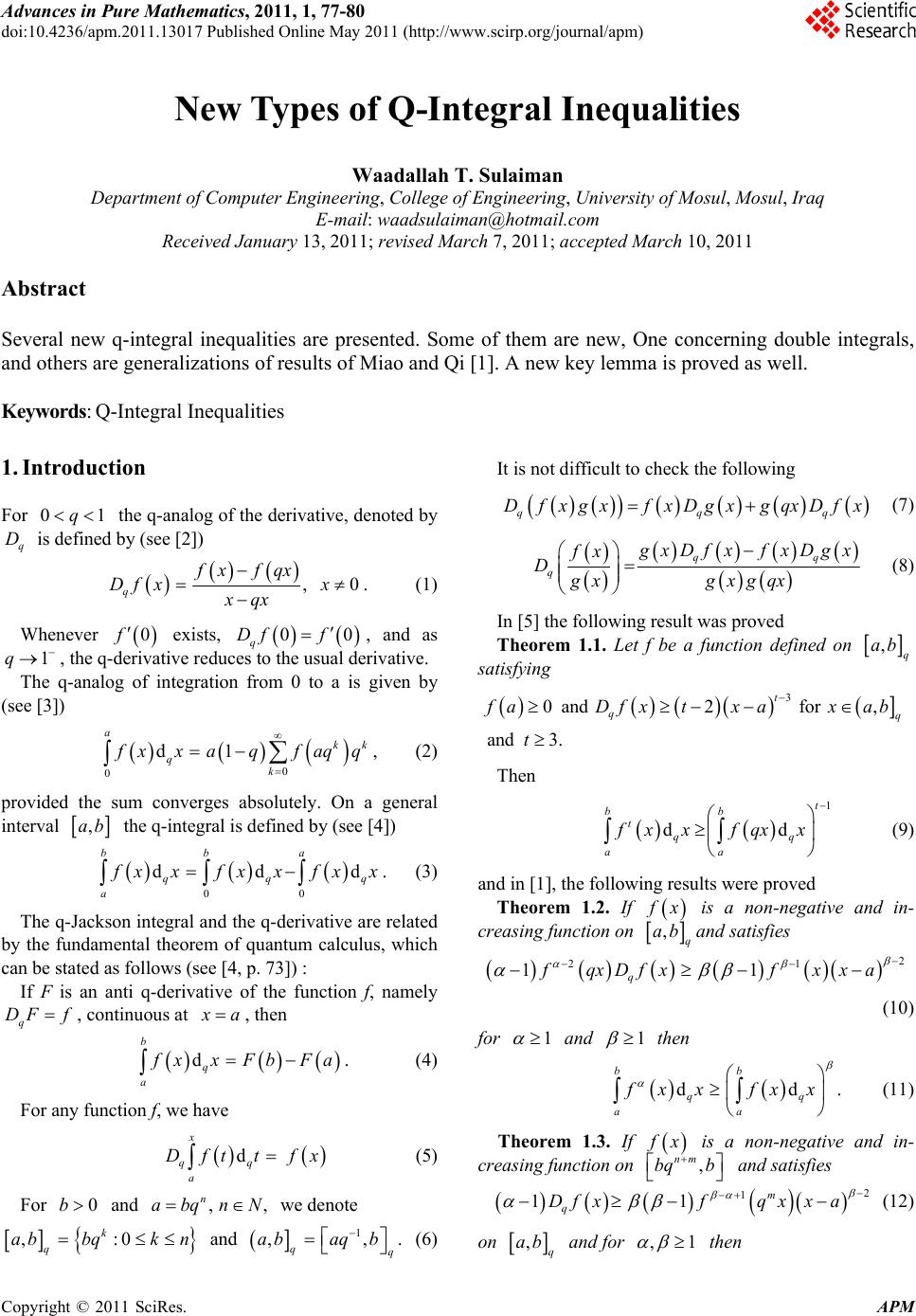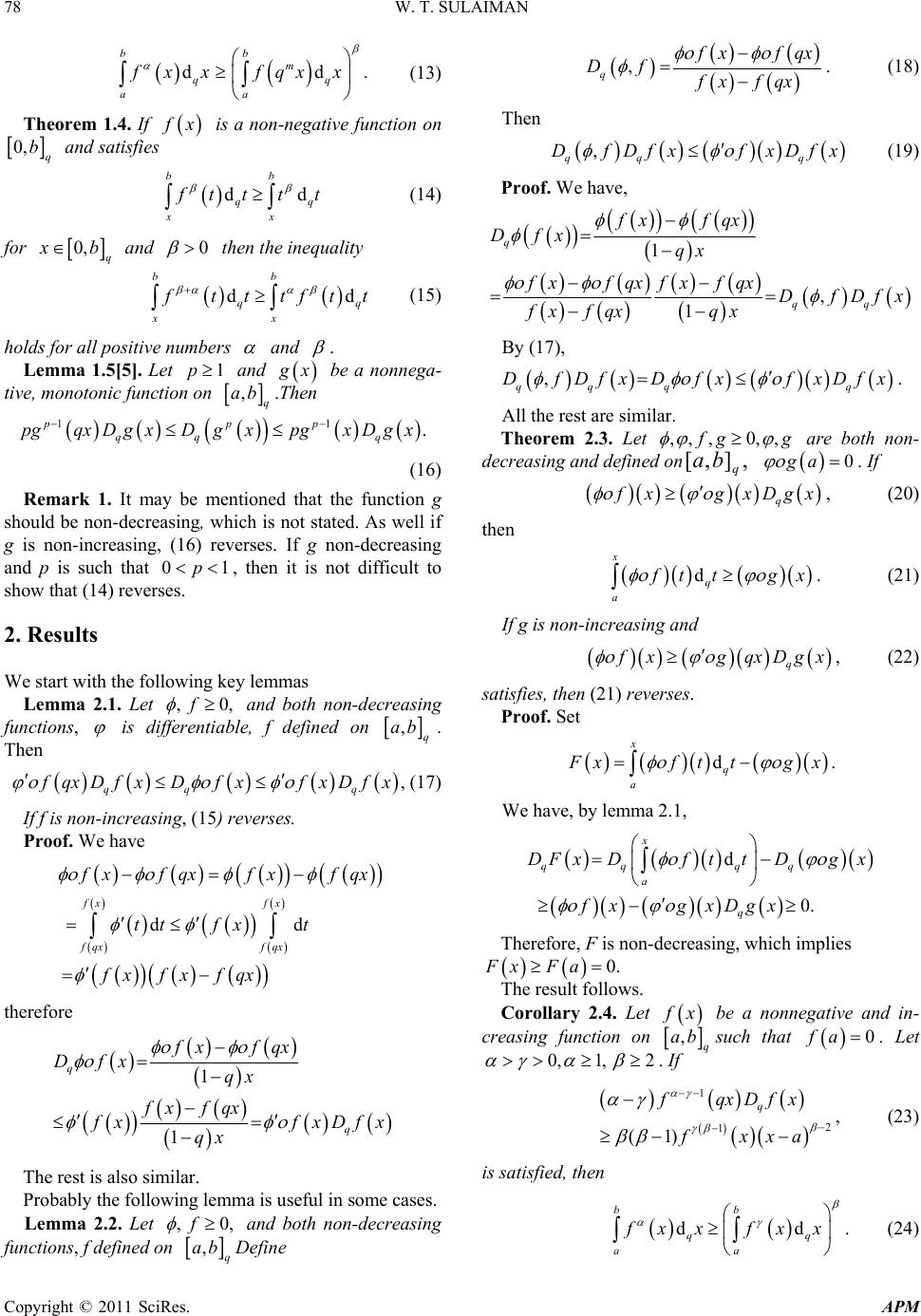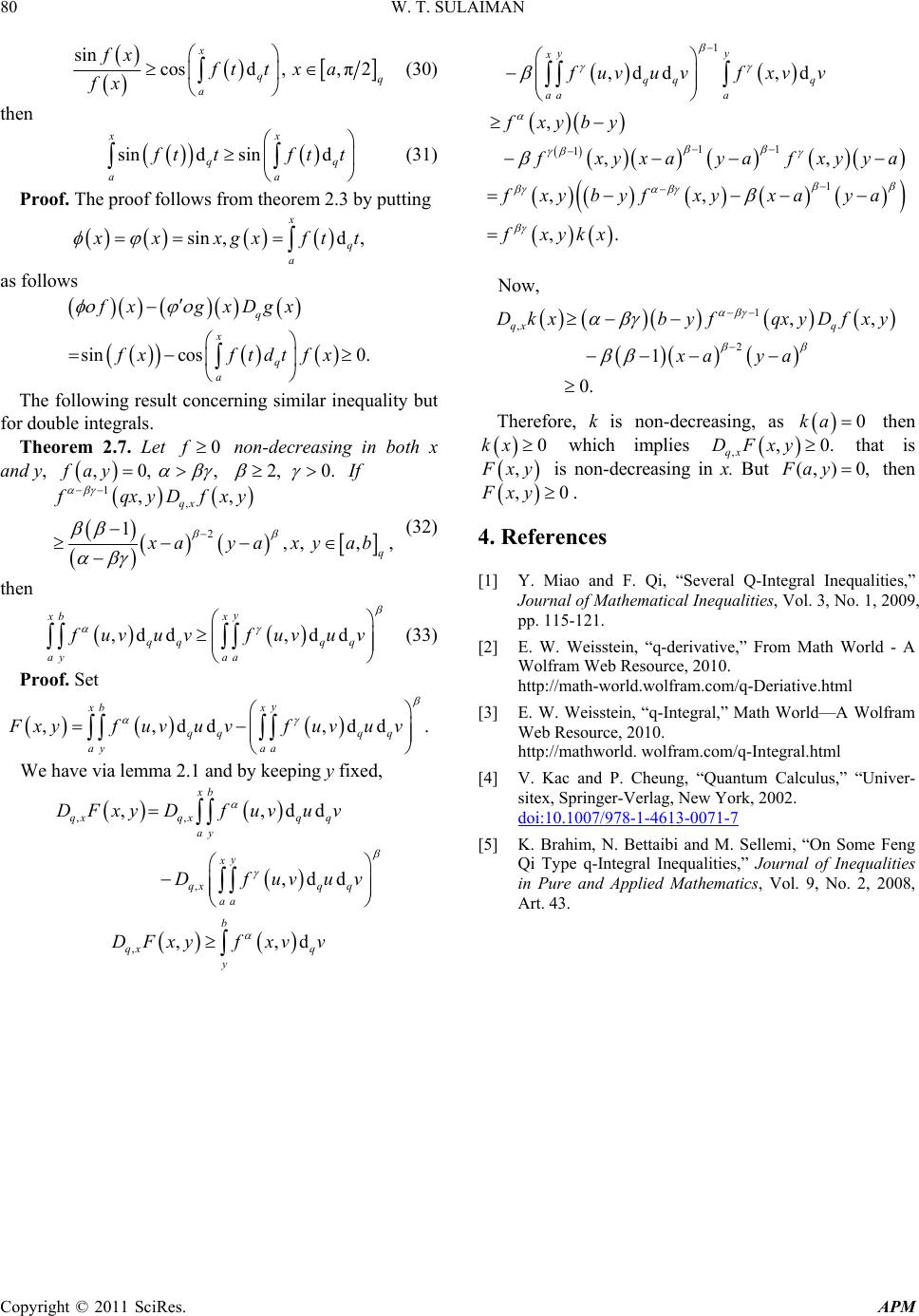Paper Menu >>
Journal Menu >>
 Advances in Pure Mathematics, 2011, 1, 77-80 doi:10.4236/apm.2011.13017 Published Online May 2011 (http://www.scirp.org/journal/apm) Copyright © 2011 SciRes. APM New Types of Q-Integral Inequalities Waadallah T. Sulaiman Department of C om put er E ngineering, College of Engineering, University of Mosul, Mosul, Iraq E-mail: waadsulaiman@hotmail.com Received January 13, 2011; revised March 7, 2011; accepted March 10, 2011 Abstract Several new q-integral inequalities are presented. Some of them are new, One concerning double integrals, and others are generalizations of results of Miao and Qi [1]. A new key lemma is proved as well. Keywords: Q-Integral Inequalities 1. Introduction For 01q the q-analog of the derivative, denoted by q D is defined by (see [2]) ,0 q fx fqx Df xx xqx . (1) Whenever 0f exists, 00 q Df f , and as 1q , the q-derivative reduces to the usual derivative. The q-analog of integration from 0 to a is given by (see [3]) 0 0 d1 akk qk f xxa qfaqq , (2) provided the sum converges absolutely. On a general interval ,ab the q-integral is defined by (see [4]) 00 ddd bba qqq a f xx fxxfxx . (3) The q-Jackson integral and the q-derivative are related by the fundamental theorem of quantum calculus, which can be stated as follows (see [4, p. 73]) : If F is an anti q-derivative of the function f, namely q DF f, continuous at x a, then d b q a f xxFbFa . (4) For any function f, we have d x qq a Dft tfx (5) For 0b and ,, n abqnN we denote ,:0 k q abbqk n and 1 ,,. qq abaq b (6) It is not difficult to check the following qqq DfxgxfxDgx gqxDfx (7) qq q g xDfxfxDgx fx Dgx gxgqx (8) In [5] the following result was proved Theorem 1.1. Let f be a function defined on ,q ab satisfying 3 0 and2for, and 3. t qq f aDfxtxaxab t Then 1 dd t bb tqq aa fx xfqx x (9) and in [1], the following results were proved Theorem 1.2. If f x is a non-negative and in- creasing function on ,q ab and satisfies 2 21 11 q fqxDfx fxxa (10) for 1 and 1 then dd. bb qq aa fxx fxx (11) Theorem 1.3. If f x is a non-negative and in- creasing function on , nm bq b and satisfies 2 1 11 m q Df xfqxxa (12) on ,q ab and for ,1 then  W. T. SULAIMAN Copyright © 2011 SciRes. APM 78 dd. bb m qq aa fxx fqxx (13) Theorem 1.4. If f x is a non-negative function on 0, q b and satisfies dd bb qq xx f ttt t (14) for 0, q x b and 0 then the inequality dd bb qq xx f tttftt (15) holds for all positive numbers and . Lemma 1.5[5]. Let 1p and g x be a nonnega- tive, monotonic function on ,q ab .Then 11 . ppp qq q pgqx DgxDgxpgxDgx (16) Remark 1. It may be mentioned that the function g should be non-decreasing, which is not stated. As well if g is non-increasing, (16) reverses. If g non-decreasing and p is such that 01p, then it is not difficult to show that (14) reverses. 2. Results We start with the following key lemmas Lemma 2.1. Let ,0,f and both non-decreasing functions, is differentiable, f defined on ,q ab . Then , qq q f qxDfx DfxfxDfx (17) If f is non-increasing, (15) reverses. Proof. We have dd fx fx fqx fqx f xfqxfx fqx tt fxt fx fx fqx therefore 1 1 q q fx fqx Dfx qx fx fqx f xfxDfx qx The rest is also similar. Probably the following lemma is useful in some cases. Lemma 2.2. Let ,0,f and both non-decreasing functions, f defined on ,q ab Define , q f xfqx Df fx fqx . (18) Then , qq q DfDfx fxDfx (19) Proof. We have, 1 , 1 q qq fx fqx Dfx qx fxfqxfxfqx DfDfx fx fqxqx By (17), , qq qq DfDf xDfxfxDfx . All the rest are similar. Theorem 2.3. Let ,,, 0,, f gg are both non- decreasing and defined on,],[q ba 0ga . If q f xgxDgx , (20) then d x q a f tt gx . (21) If g is non-increasing and q f xgqxDgx , (22) satisfies, then (21) reverses. Proof. Set d x q a F xfttgx . We have, by lemma 2.1, d 0. x qq qq a q DF xDfttDgx fx gxDgx Therefore, F is non-decreasing, which implies 0.Fx Fa The result follows. Corollary 2.4. Let f x be a nonnegative and in- creasing function on ,q ab such that 0fa . Let 0, 1,2 . If 1 2 1 (1) q fqxDfx fxxa , (23) is satisfied, then dd bb qq aa fxx fxx . (24)  W. T. SULAIMAN Copyright © 2011 SciRes. APM 79 Furthermore, if 1 2 1 (1) q fqxDfx fqxxa (25) is satisfied, then dd bb qq aa f xx fqxx (26) Proof. For ,q x ab let ,, d x q a x xxxgxfxx then, we have, via lemma 1.5, 1 1 . q x q a x q a fx gxDgx fxftdtfx fxf xftdtfxhx Now, 1 1 2 1 2 1 1 1 0. x qqq q a q x q a q Dh xDfxDft dt fqxDfx f tdtfx fqxDfx fxxa Therefore, hx is non-decreasing, but 0ha , then 0hx. The result follows by theorem 2.3. The proof of the second part is similar, and therefore, it is omitted. Remark 2. Theorem 1.2 follows from corollary 2.4, the first part, by putting 1. Theorem 2.5. Let , f g are non-negative functions on ,q ab , either f or g is non-decreasing and they sat- isfies dd,,, bb qq q xx f tt gttxab (27) then the inequality dd bb qq xx f tt ftgtt (28) holds for all positive numbers and . Proof. Suppose that f is non-decreasing. Using the fact d b qq a f bfa Dfxx we have dd d d d d. bbx qqqq baa bb b qqq q at a bb b qqq q at a bx qq q aa b q a f xxfxDftdtfax Dftfxdxdtfaf xx Dftgxdxdtfagxx gx Dftdtfax fxgxx Now, suppose g is non-decreasing, then, we have d dd dd d dd d dd d. b q b bx qq q aa bb b qqqq at a bb b qqq q at a bx qq q aa b q a fxgxx fx Dgttgax Dgtfxxtgafxx Dgtg xxtgag xx gxDgttfax gxx (29) Using the arithmetic geometric inequality yields . f xgxfxgx Integrating the above inequality and making use of (29) gives dd dd. bb aa bb aa f xxg xx fxgxxg xx The result follows. Remark 3. Theorem 1.4 follows from theorem 2.5 by putting 0, .agxx Corollary 2.6. Let 0f. If  W. T. SULAIMAN Copyright © 2011 SciRes. APM 80 sin cosd,, π2 x qq a fx fttxa fx (30) then sind sind xx qq aa f tt ftt (31) Proof. The proof follows from theorem 2.3 by putting sin ,d , x q a x xxgxftt as follows sin cos0. q x q a fx gxDgx fx ftdtfx The following result concerning similar inequality but for double integrals. Theorem 2.7. Let 0f non-decreasing in both x and y, ,0,fay, 2, 0. If 1 , 2 ,, 1,,, , qx q fqxyDfxy x ayaxyab (32) then ,dd ,dd y xb x qq qq ay aa f uv uvfuv uv (33) Proof. Set ,,dd,dd. y xb x qq qq ay aa Fxyfuvu vfuvu v We have via lemma 2.1 and by keeping y fixed, ,, , ,,dd ,dd xb qxqxq q ay y x qxq q aa DFxyDfuvu v Dfuvuv ,,,d b qx q y DFxyf xvv 1 11 1 1 ,dd,d , ,, ,, ,. yy x qq q aa a fuv uvfxv v fxyby f xyxayafxyy a fxybyfxyxaya fxykx Now, 1 , 2 ,, 1 0. qx q DkxbyfqxyDfxy xa ya Therefore, k is non-decreasing, as 0ka then 0kx which implies ,,0. qx DFxy that is , F xy is non-decreasing in x. But ,0),( yaF then ,0Fxy. 4. References [1] Y. Miao and F. Qi, “Several Q-Integral Inequalities,” Journal of Mathematical Inequalities, Vol. 3, No. 1, 2009, pp. 115-121. [2] E. W. Weisstein, “q-derivative,” From Math World - A Wolfram Web Resource, 2010. http://math-world.wolfram.com/q-Deriative.html [3] E. W. Weisstein, “q-Integral,” Math World—A Wolfram Web Resource, 2010. http://mathworld. wolfram.com/q-Integral.html [4] V. Kac and P. Cheung, “Quantum Calculus,” “Univer- sitex, Springer-Verlag, New York, 2002. doi:10.1007/978-1-4613-0071-7 [5] K. Brahim, N. Bettaibi and M. Sellemi, “On Some Feng Qi Type q-Integral Inequalities,” Journal of Inequalities in Pure and Applied Mathematics, Vol. 9, No. 2, 2008, Art. 43. |

